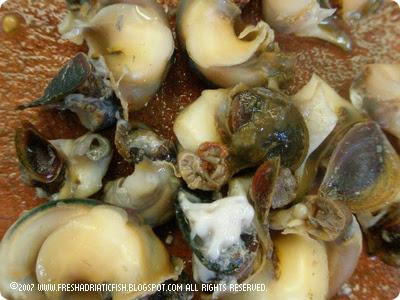
I know it is not that time of the year yet, but when I read about this month SHF hosted by The Passionate cook with the theme “Going local!”, Bobici just jumped in my mind and I desperately wanted to participate!
Well, traditional Dalmatian sweets in general are very tasteful. The main ingredient are local fruit: figs, raisins, almonds, walnuts… honey is often used instead of the sugar…
If you ever visit Dalmatic coast, island or inland you just have to try some of these: Mandulat, Rafioli, Smokvenjak (Hib), Rožata (in Split it is called Rožada), Fritule, Kroštule… and many, many others delicious sweets, cookies, cakes…
But today, I’ll write about Bobici, since their background is so fascinating!
Bobici, meaning “little broad beans” (“broad beans” = “bob” in Croatian), are small cakes that got its name form the old believe that the beans represent some sort of media for the direct communication between the world of dead and the world of living. Because of their ability to bring alive the souls of the dead the beans were present in the funeral ceremony in old Greece, Egypt and Rome, but also in other parts of the world. So baking and sharing the cookies in shape of beans - Bobici represents the symbolic reunion of departed and alive.
In Catholic world the Bobici were traditionally served on Day of Dead (or All Souls day) that is always on November 2. It is a Roman Catholic day of remembrance for friends and loved ones who have passed away. In Italy there are similar cookies called "Fave dei morti" meaning "Beans of the Dead".
Today in Split Bobici are very popular in everyday life and they are considered Split’s gastronomical souvenir. They are even industrially produced and are the most popular product of Bobis, the oldest pastry industry in Croatia, based in Split.
So if you ever come to Split find Bobis shop and ask for Bobići (Bobichi). You can find them in many others souvenir or delicates shops were you can fined home made Bobici that are for sure more tasteful than those form Bobis which are industrially produced. Or even better, buy local ingredients and bake them yourself!
Bobici
250 g Unbleached and unpeeled almonds
250 g Sugar
1 egg
1 spoon of Maraschino
grated nutmeg
½ lemon zest
1 spoon of biscuit or Savoiardi crumbs
1 spoon of grated dark chocolate
Lightly toast the almonds and let them cool. Half of the almonds grind until they get flour like consistency (if you are doing this in a food processor be careful not to overgrind since almond are quite oily and they can easily get creamy. We do not want that!). Other half chop finely using knife (so that crumbs are size of couscous). Mix both halves back together.
Mix sugar with egg yolk. Grate some lemons zest. Add almonds, maraschino or some other domestic brandy, nutmeg, and beaten egg white (the “snow” from whites should form firm foam. Test it by turning the bowl upside down. Whites should stay in bowl.).
Mix it till you get firm dough and divide it in two halves. For white Bobici add same biscuit crumbs or grated Savoiardi. To the other half add grated dark chocolate.
Damp your hands and roll the dough between them to get long rolls about 1,5 cm thick. Cut them in 2 cm long pieces and then shape them into small balls. Lightly press each ball with finger to make a shallow pit.
Grease the baking dish or paper preferably with natural bee wax but butter or oil will do just fine. Place carefully the balls on it. Dry them in the oven on 50°C for about 3 hours.
This is basic recipe based on recipe form “Dalmatinska kuharica” by Dika Marjanović-Radica. There are lots of variants depending of the place you visit.
































